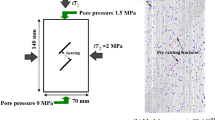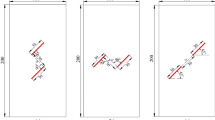Abstract
By improving the original transverse isotropic constitutive model of FLAC3D and secondary development, the theory of original smeared crack model was modified and introduced into the simulation of progressive fracture of rock mass from the research focus of concrete. Rotating smeared crack model is adopted, which means the smeared crack surface inside element changes every moment with the redistribution of stress. The maximum tensile strain theory was defined as the damage criterion of mesoscopic element to establish degeneration principles. The dynamic strike, dip direction and dip angle of the smeared crack surface were deduced in FLAC3D, and the synergistic relationship between the elastic modulus, shear modulus and tensile damage was quantified, through which programming was realized the first time using finite difference method. The crack propagation path and lap mode of rock specimen under three groups of tension-shear test conditions were studied and analysed. The simulation results match well with experiments by predecessors, which demonstrates validity and feasibility of this new method. Moreover, the proposed model was also applied to investigate the slope excavation of Dagangshan Hydropower Station in China. The whole process of continuous deterioration and expansion of damaged zone caused by unloading stress was studied. And overload test was performed to calculate the safety factor, showing good effect.
Article Highlights
-
Large irregular plastic zones for elastoplastic and original transverse isotropic models are overcome.
-
The magnitudes and directions of the three principal strains in FLAC3D are deduced.
-
The evolution of Poisson's ratio is connected directly with the damage of elastic modulus.
-
The element is supposed to show damage only when maximum principal tensile strain is above 0.
-
Relationship between elastic modulus, shear modulus and tensile damage was quantified.

















Similar content being viewed by others
Abbreviations
- \(\varepsilon_{n}\) :
-
Normal strain perpendicular to the crack surface
- \(\varepsilon_{s}\) :
-
Normal strain parallel to the crack surface
- \(\gamma_{ns}\) :
-
Shear strain
- \(\sigma_{n}\) :
-
Normal stress perpendicular to the crack surface
- \(\sigma_{s}\) :
-
Normal stress parallel to the crack surface
- \(\sigma_{ns}\) :
-
Shear stress at the crack surface
- \(E\) :
-
Elastic modulus
- \(\mu\) :
-
Reduction coefficient of elastic modulus
- \(G\) :
-
Shear modulus
- \(\beta\) :
-
Shear retention coefficient
- \(\sigma_{1}\) :
-
First principal stress
- \(\sigma_{2}\) :
-
Second principal stress
- \(\sigma_{3}\) :
-
Third principal stress
- dd :
-
Dip direction of the isotropic plane
- dip :
-
Dip angle of the isotropic plane
- E 1 :
-
Elastic modulus of the isotropic plane
- \(E_{1} ^{\prime}\) :
-
Damaged elastic modulus of the isotropic plane
- E 3 :
-
Elastic modulus of the anisotropic plane
- G 12, G 13, G 23 :
-
Shear moduli of the transverse isotropic constitutive model
- \(G_{12} ^{\prime}\) :
-
Damaged shear modulus
- \(\nu_{12}\), \(\nu_{13}\), \(\nu_{23}\) :
-
Poisson's ratios of the transverse isotropic constitutive model
- \(\nu_{12} ^{\prime}\) :
-
Damaged Poisson's ratio
- \(D\) :
-
Damage variable of elastic modulus
- \(\varepsilon_{1}\) :
-
First principal strain
- \(\varepsilon_{3}\) :
-
Third principal strain
- \(\varepsilon_{\max }\) :
-
Ultimate tensile strain
- \(D_{u}\) :
-
Shear damage variable
- \(D_{T}\) :
-
Tensile damage variable
- \(\varepsilon_{11} ,\varepsilon_{22} ,\varepsilon_{33} ,\varepsilon_{12} ,\varepsilon_{13} ,\varepsilon_{23}\) :
-
Six strain components
- \(m\) :
-
Undetermined constant
- \(\omega\) :
-
Strain characteristic angle
References
Aghajanzadeh SM, Mirzabozorg H (2019) Concrete fracture process modeling by combination of extended finite element method and smeared crack approach. Theor Appl Fract Mec 101:306–319
Amir P, AmirJavade M (2020) Investigation of size effect and smeared crack models in ordinary and dam concrete fracture tests. Eng Fract Mech 226:106863
Bažant ZP (2002) Concrete fracture models: testing and practice. Eng Fract Mech 69(2):165–205
Bi JH, Huo LY, Zhao Y, Qiao HY (2020) Modified the smeared crack constitutive model of fiber reinforced concrete under uniaxial loading. Constr Build Mater 250:118916
Cundall PA, Strack ODL (1979) A discrete numerical model for granular assemblies. Geotechnique 29:47–65
Feng F, Li XB, Rostami J, Peng DX, Li DY, Du K (2019) Numerical investigation of hard rock strength and fracturing under polyaxial compression based on Mogi-coulomb failure criterion. Int J Geomech 19(4):04019005
Fu JW, Zhang XZ, Zhu WS, Chen K, Guan JF (2017) Simulating progressive failure in brittle jointed rock masses using a modified elastic-brittle model and the application. Eng Fract Mech 178:212–230
Fu JW, Liu SL, Zhu WS, Zhou H, Sun ZC (2018) Experiments on failure process of new rock-like specimens with two internal cracks under biaxial loading and the 3-D simulation. Acta Geotech 13(4):853–867
Gamino AL, Manzoli OL, Sousa JLADE, Bittencourt TN (2010) 2D evaluation of crack openings using smeared and embedded crack models. Comput Concrete 7(6):483–496
Gong FQ, Yan JY, Li XB, Luo S (2019) A peak-strength strain energy storage index for rock burst proneness of rock materials. Int J Rock Mech Min 117:76–89
Guo YH (2014) A statistical damage model of rock failure and fractured rock mass gradual damage numerical simulation. Ph.D. Thesis, Shandong University
Haeri H, Shahriar K, Marji MF, Moarefvand P (2014) Experimental and numerical study of crack propagation and coalescence in pre-cracked rock-like disks. Int J Rock Mech Min 67:20–28
Hou C, Jin XC, Fan XL, Xu R, Wang ZY (2019) A generalized maximum energy release rate criterion for mixed mode fracture analysis of brittle and quasi-brittle materials. Theor Appl Fract Mec 100:78–85
Jiao YY, Zhang XL, Zhao J (2012) Two-dimensional DDA contact constitutive model for simulating rock fragmentation. J Eng Mech 138(2):199–209
Konietzky H, Heftenberger A, Feige M (2009) Life time prediction for rocks under static compressive and tensile loads – a new simulation approach. Acta Geotech 4:73–78
Lee J, Hong JW (2019) Morphological aspects of crack growth in rock materials with various flaws. Int J Numer Anal Met 43(10):1854–1866
Li SC, Feng XD, Li SC (2013) Numerical model for the zonal disintegration of the rock mass around deep underground workings. Theor Appl Fract Mec 67–68:65–73
Li Y, Zhou H, Zhu WS, Li SC, Liu J (2015) Numerical study on crack propagation in brittle jointed rock mass influenced by fracture water pressure. Materials 8(6):3364–3376
Liu HY, Xie TC (2020) Numerical simulation of the mechanical behavior of rock mass with different scale flaws and its application. Arab J Geosci. https://doi.org/10.1007/s12517-020-5261-8
Liu C, Xu Q, Shi B, Deng S, Zhu HH (2017) Mechanical properties and energy conversion of 3D close-packed lattice model for brittle rocks. Comput Geosci 103:12–20
Liu XS, Fan DY, Tan YL, Song SL, Li XF, Ning JG, Gu QH, Ma Q (2021) Failure evolution and instability mechanism of surrounding rock for close-distance parallel chambers with super-large section in deep coal mines. Int J Geomech 21(5):04021049
Ning JG, Gu QH, Wang J, Hu SC, Ma Q, Qiu PQ (2018) Strain-softening model for marble considering the degradation of elastic modulus. Arab J Sci Eng 43(10):5635–5643
Nooru–Mohamed MB (1992) Mixed mode fracture of concrete: an experimental approach. Ph.D. Thesis, Delft University.
Rashid YR (1968) Ultimate strength analysis of prestressed concrete pressure vessels. Nucl Eng Des 7(4):334–344
Thybo Anna Emilie A, Alexander M, Henrik S (2017) Smeared crack modelling approach for corrosion-induced concrete damage. Mater Struct 50(2):146
Wang SY, Sloan SW, Sheng DC, Yang SQ, Tang CA (2014) Numerical study of failure behaviour of pre-cracked rock specimens under conventional triaxial compression. Int J Solids Struct 51(5):1132–1148
Wang YT, Zhou XP, Kou MM (2018) Three-dimensional numerical study on the failure characteristics of intermittent fissures under compressive-shear loads. Acta Geotech 14(4):1161–1193
Wei MD, Dai F, Xu NW, Liu Y, Zhao T (2017) Fracture prediction of rocks under mode I and mode II loading using the generalized maximum tangential strain criterion. Eng Fract Mech 186:21–38
Wen ZJ, Tian L, Jiang YJ, Zuo YJ, Meng FB, Dong Y, Lin G, Yang T, Lv DW (2019) Research on damage constitutive model of inhomogeneous rocks based on strain energy density. Chin J Rock Mech Eng 38(7):1332–1343 (In Chinese)
Xie HP, Li LY, Ju Y, Peng RD, Yang YM (2011) Energy analysis for damage and catastrophic failure of rocks. Sci China Technol Sc 54(Suppl 1):199–209
Yu X, Da Gama CD, Na Y, Wang Q, Xie Q (2005) Deformation behaviour of rocks under compression and direct tension. J S Afr Inst Min Metall 105(1):55–62
Zhang K, Cao P, Meng JJ, Li KH, Fan WC (2015) Modeling the progressive failure of jointed rock slope using fracture mechanics and the strength reduction method. Rock Mech Rock Eng 48(2):771–785
Zhang ZS, Wang SH, Wang CG, Wang PY (2021) A study on rock mass crack propagation and coalescence simulation based on improved numerical manifold method (NMM). Geomech Geophys Geo. https://doi.org/10.1007/s40948-020-00193-7
Zhao BY, Liu DY, Xue KX (2011) Experimental study on direct tension properties of red sandstone in Chongqing. Geotechnical Investigation and Surveying 39(4):9–12 (In Chinese)
Zhou XP, Jia ZM, Wang LF (2021) A field-enriched finite element method for brittle fracture in rocks subjected to mixed mode loading. Eng Anal Bound Elem 129:105–124
Acknowledgements
The authors express sincere appreciation to anonymous reviewers for their valuable comments on improving this study. This study is funded by National Natural Science Foundation of China (Grant Nos. 51608117 and 52004098), and Key Specialized Research and Development Breakthrough Program in Henan province (Grant No. 192102210051).
Author information
Authors and Affiliations
Contributions
JF: Theoretical derivation on the dynamic strike, dip direction and dip angle of the smeared crack surface, software programming, writing-original draft, data analysis. HC: Simulation work of the laboratory tests and slope excavation project. YG: Theoretical innovation on the synergistic relationship between the elastic modulus, shear modulus and tensile damage. SL: Field monitoring and data analysis of the slope project. RH: Writing-review & editing.
Corresponding author
Ethics declarations
Conflict of interest
The authors declare that they have no known competing financial interests or personal relationships that could have appeared to influence the work reported in this paper.
Additional information
Publisher's Note
Springer Nature remains neutral with regard to jurisdictional claims in published maps and institutional affiliations.
Rights and permissions
About this article
Cite this article
Fu, J., Cheng, H., Guo, Y. et al. Implementation and engineering application of an improved rotating smeared crack model in rock mass fracture. Geomech. Geophys. Geo-energ. Geo-resour. 8, 9 (2022). https://doi.org/10.1007/s40948-021-00318-6
Received:
Accepted:
Published:
DOI: https://doi.org/10.1007/s40948-021-00318-6




